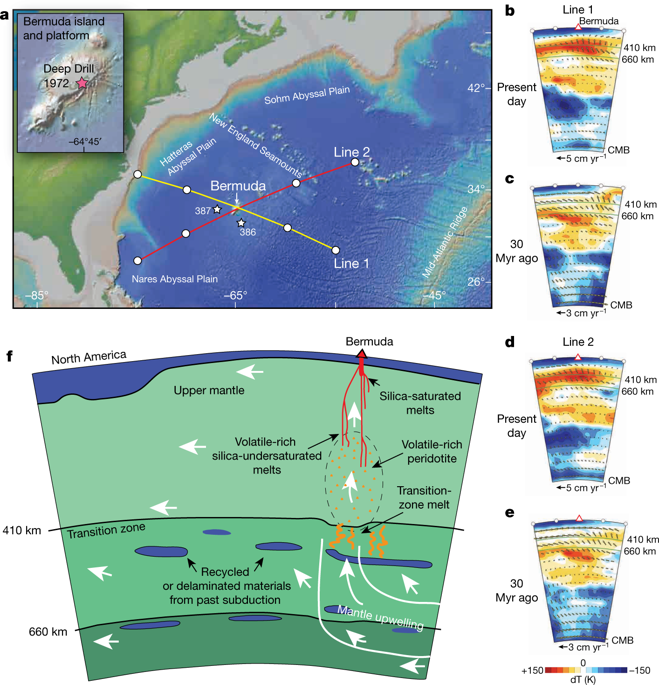Our official English website, www.x-mol.net, welcomes your
feedback! (Note: you will need to create a separate account there.)
Sampling the volatile-rich transition zone beneath Bermuda
Nature ( IF 50.5 ) Pub Date : 2019-05-01 , DOI: 10.1038/s41586-019-1183-6 Sarah E Mazza 1 , Esteban Gazel 2 , Michael Bizimis 3 , Robert Moucha 4 , Paul Béguelin 3 , Elizabeth A Johnson 5 , Ryan J McAleer 6 , Alexander V Sobolev 7, 8
Nature ( IF 50.5 ) Pub Date : 2019-05-01 , DOI: 10.1038/s41586-019-1183-6 Sarah E Mazza 1 , Esteban Gazel 2 , Michael Bizimis 3 , Robert Moucha 4 , Paul Béguelin 3 , Elizabeth A Johnson 5 , Ryan J McAleer 6 , Alexander V Sobolev 7, 8
Affiliation

|
Intraplate magmatic provinces found away from plate boundaries provide direct sampling of the composition and heterogeneity of the Earth’s mantle. The chemical heterogeneities that have been observed in the mantle are usually attributed to recycling during subduction1–3, which allows for the addition of volatiles and incompatible elements into the mantle. Although many intraplate volcanoes sample deep-mantle reservoirs—possibly at the core–mantle boundary4—not all intraplate volcanoes are deep-rooted5, and reservoirs in other, shallower boundary layers are likely to participate in magma generation. Here we present evidence that suggests Bermuda sampled a previously unknown mantle domain, characterized by silica-undersaturated melts that are substantially enriched in incompatible elements and volatiles, and a unique, extreme isotopic signature. To our knowledge, Bermuda records the most radiogenic 206Pb/204Pb isotopes that have been documented in an ocean basin (with 206Pb/204Pb ratios of 19.9–21.7) using high-precision methods. Together with low 207Pb/204Pb ratios (15.5–15.6) and relatively invariant Sr, Nd, and Hf isotopes, the data suggest that this source must be less than 650 million years old. We therefore interpret the Bermuda source as a previously unknown, transient mantle reservoir that resulted from the recycling and storage of incompatible elements and volatiles6–8 in the transition zone (between the upper and lower mantle), aided by the fractionation of lead in a mineral that is stable only in this boundary layer, such as K-hollandite9,10. We suggest that recent recycling into the transition zone, related to subduction events during the formation of Pangea, is the reason why this reservoir has only been found in the Atlantic Ocean. Our geodynamic models suggest that this boundary layer was sampled by disturbances related to mantle flow. Seismic studies and diamond inclusions6,7 have shown that recycled materials can be stored in the transition zone11. For the first time, to our knowledge, we show geochemical evidence that this storage is key to the generation of extreme isotopic domains that were previously thought to be related only to deep recycling.The formation of Bermuda sampled a previously unknown mantle reservoir that is characterized by silica-undersaturated melts enriched in volatiles and by a unique lead isotopic signature, which suggests that the source is young.
中文翻译:

对百慕大下方富含挥发性物质的过渡区进行采样
在远离板块边界的地方发现的板内岩浆区提供了对地幔成分和异质性的直接采样。在地幔中观察到的化学异质性通常归因于俯冲过程中的再循环1-3,这允许将挥发物和不相容的元素添加到地幔中。尽管许多板内火山对深部地幔储层进行了取样——可能位于核心-地幔边界4——但并非所有板内火山都是根深蒂固的5,其他较浅边界层的储层可能参与岩浆生成。在这里,我们提供的证据表明百慕大采样了一个以前未知的地幔域,其特征是二氧化硅不饱和熔体,其中大量富含不相容的元素和挥发物,以及独特的极端同位素特征。据我们所知,百慕大使用高精度方法记录了在海洋盆地中记录的最具放射性的 206Pb/204Pb 同位素(206Pb/204Pb 比率为 19.9-21.7)。连同较低的 207Pb/204Pb 比率 (15.5–15.6) 和相对不变的 Sr、Nd 和 Hf 同位素,数据表明该来源的历史必须小于 6.5 亿年。因此,我们将百慕大源解释为一个以前未知的瞬态地幔储层,它是由过渡带(上地幔和下地幔之间)不相容元素和挥发物 6-8 的回收和储存产生的,这得益于矿物中铅的分馏仅在该边界层中稳定,例如 K-hollandite9,10。我们建议最近回收到过渡带,与泛大陆形成期间的俯冲事件有关,这就是为什么这个水库只在大西洋被发现的原因。我们的地球动力学模型表明,这个边界层是由与地幔流相关的扰动采样的。地震研究和金刚石内含物 6、7 表明,回收材料可以储存在过渡区 11。据我们所知,我们第一次展示了地球化学证据,表明这种储存是产生极端同位素域的关键,以前认为这些域仅与深度循环有关。百慕大的形成采样了一个以前未知的地幔储层,其特征是通过富含挥发物的二氧化硅不饱和熔体和独特的铅同位素特征,这表明来源很年轻。我们的地球动力学模型表明,这个边界层是由与地幔流相关的扰动采样的。地震研究和金刚石内含物 6、7 表明,回收材料可以储存在过渡区 11。据我们所知,我们第一次展示了地球化学证据,表明这种储存是产生极端同位素域的关键,以前认为这些域仅与深度循环有关。百慕大的形成采样了一个以前未知的地幔储层,其特征是通过富含挥发物的二氧化硅不饱和熔体和独特的铅同位素特征,这表明来源很年轻。我们的地球动力学模型表明,这个边界层是由与地幔流相关的扰动采样的。地震研究和金刚石内含物 6、7 表明,回收材料可以储存在过渡区 11。据我们所知,我们第一次展示了地球化学证据,表明这种储存是产生极端同位素域的关键,以前认为这些域仅与深度循环有关。百慕大的形成采样了一个以前未知的地幔储层,其特征是通过富含挥发物的二氧化硅不饱和熔体和独特的铅同位素特征,这表明来源很年轻。
更新日期:2019-05-01
中文翻译:

对百慕大下方富含挥发性物质的过渡区进行采样
在远离板块边界的地方发现的板内岩浆区提供了对地幔成分和异质性的直接采样。在地幔中观察到的化学异质性通常归因于俯冲过程中的再循环1-3,这允许将挥发物和不相容的元素添加到地幔中。尽管许多板内火山对深部地幔储层进行了取样——可能位于核心-地幔边界4——但并非所有板内火山都是根深蒂固的5,其他较浅边界层的储层可能参与岩浆生成。在这里,我们提供的证据表明百慕大采样了一个以前未知的地幔域,其特征是二氧化硅不饱和熔体,其中大量富含不相容的元素和挥发物,以及独特的极端同位素特征。据我们所知,百慕大使用高精度方法记录了在海洋盆地中记录的最具放射性的 206Pb/204Pb 同位素(206Pb/204Pb 比率为 19.9-21.7)。连同较低的 207Pb/204Pb 比率 (15.5–15.6) 和相对不变的 Sr、Nd 和 Hf 同位素,数据表明该来源的历史必须小于 6.5 亿年。因此,我们将百慕大源解释为一个以前未知的瞬态地幔储层,它是由过渡带(上地幔和下地幔之间)不相容元素和挥发物 6-8 的回收和储存产生的,这得益于矿物中铅的分馏仅在该边界层中稳定,例如 K-hollandite9,10。我们建议最近回收到过渡带,与泛大陆形成期间的俯冲事件有关,这就是为什么这个水库只在大西洋被发现的原因。我们的地球动力学模型表明,这个边界层是由与地幔流相关的扰动采样的。地震研究和金刚石内含物 6、7 表明,回收材料可以储存在过渡区 11。据我们所知,我们第一次展示了地球化学证据,表明这种储存是产生极端同位素域的关键,以前认为这些域仅与深度循环有关。百慕大的形成采样了一个以前未知的地幔储层,其特征是通过富含挥发物的二氧化硅不饱和熔体和独特的铅同位素特征,这表明来源很年轻。我们的地球动力学模型表明,这个边界层是由与地幔流相关的扰动采样的。地震研究和金刚石内含物 6、7 表明,回收材料可以储存在过渡区 11。据我们所知,我们第一次展示了地球化学证据,表明这种储存是产生极端同位素域的关键,以前认为这些域仅与深度循环有关。百慕大的形成采样了一个以前未知的地幔储层,其特征是通过富含挥发物的二氧化硅不饱和熔体和独特的铅同位素特征,这表明来源很年轻。我们的地球动力学模型表明,这个边界层是由与地幔流相关的扰动采样的。地震研究和金刚石内含物 6、7 表明,回收材料可以储存在过渡区 11。据我们所知,我们第一次展示了地球化学证据,表明这种储存是产生极端同位素域的关键,以前认为这些域仅与深度循环有关。百慕大的形成采样了一个以前未知的地幔储层,其特征是通过富含挥发物的二氧化硅不饱和熔体和独特的铅同位素特征,这表明来源很年轻。









































 京公网安备 11010802027423号
京公网安备 11010802027423号